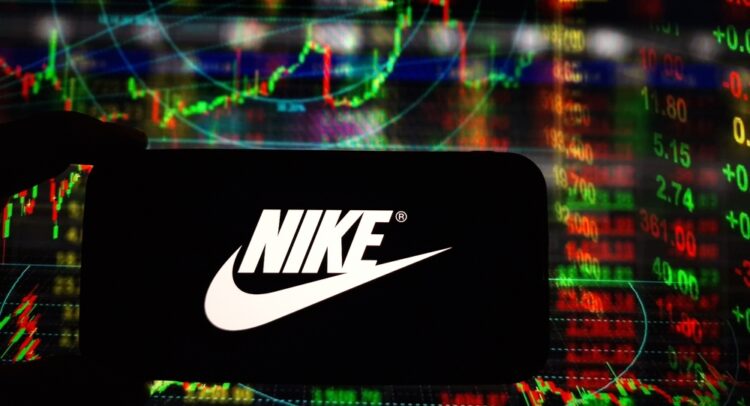Things aren’t looking great for Nike (NKE) shareholders. Since Nike’s previous fiscal Q3 earnings report, despite beating expectations across the board, the company’s shares have dropped another 17%, bringing total losses to over 38% in the past twelve months.
Confident Investing Starts Here:
- Easily unpack a company's performance with TipRanks' new KPI Data for smart investment decisions
- Receive undervalued, market resilient stocks right to your inbox with TipRanks' Smart Value Newsletter
Now trading below $70, the stock has reached its lowest level since 2018, highlighting the rate of decline the company has faced in recent years, driven by a combination of structural headwinds, cyclical challenges, and operational missteps. In contrast to the S&P 500, NKE stock has underperformed by ~16% this year.
That said, the Beaverton, Oregon-based apparel giant is set to report its fiscal Q4 earnings on June 26, after the closing bell. I believe there are a few reasons that suggest a consistent shift in bearish sentiment. The good news is that with the market prepared for the worst, even small improvements and progress in the turnaround strategy could have a more positive—or less negative—impact. For now, Nike is a Hold ahead of its earnings.
Nike Hurdles Operational Bumps
For starters, there’s a secular shift—not just a temporary trend—where consumers are moving toward smaller, niche brands like On (ONON), Hoka (DECK), and Lululemon (LULU), rather than global giants like Nike. China, once a significant growth engine for Nike, has also become a major headwind, pressured by the rise of local competitors, geopolitical tensions, and weak consumer spending.
Additionally, Nike’s global shift to DTC (Direct-to-Consumer) has led to higher logistics costs, steeper customer acquisition expenses, and greater operational complexity. This has been exacerbated by a lack of meaningful product innovation, with the company still relying heavily on legacy franchises like Air Jordan and Air Force 1, rather than introducing new, tech-driven products.
In the most recent quarter, Q3 2024, Nike once again posted disappointing numbers. Revenue dropped 9%, marking the fourth consecutive quarter of negative growth. Net income collapsed 32% year-over-year, while EPS fell 30%. In my view—and likely the market’s—these financial results only reinforce the idea that Nike’s challenges are more than just temporary; they’re structural.
What’s Next for Nike in 4Q24 and Beyond
It’s essential to clarify that structural headwinds don’t necessarily mean the end of the road for Nike’s investment thesis; instead, they signal that changes are needed for a successful turnaround.
Under the new leadership of CEO Elliot Hill, Nike has been working to rebuild wholesale partnerships (like JD.com (JD), Foot Locker (FL), Dick’s Sporting Goods (DKS)), investing in new tech-driven product launches slated for 2025 (including collaborations with influencers like Kim Kardashian), and announcing plans to cut $2 billion in costs over the next three years.
On the short-term cyclical side, Nike has also focused on addressing its inventory issues, moving away from excess stock that had led to heavy discounting over the past two years. In the last quarter, inventory levels fell by 2% year-over-year, although they remain elevated across all regions.
Since these strategies don’t produce immediate results, Nike’s management has guided that Q4 revenues will likely still decline in the mid-teens. At the same time, gross margins are expected to contract by 400 to 500 basis points—to a range of 39% to 40%—which is well below the five-year average of 44%. The silver lining is that management attributes this margin compression mainly to inventory liquidations and restructuring charges, which are expected to be temporary.
With that in mind, I expect the primary focus on earnings day—beyond beating the $0.12 EPS and $10.7 billion revenue estimates—to be on any early signs of progress in turnaround efforts, such as cost-cutting and less severe negative growth, along with continued reduction in inventories at a healthy pace.

What’s interesting is that despite the current depressed share price, Nike still trades at a free cash flow yield of 5.7%—well above the U.S. 10-year Treasury yield (~4.4%) and roughly in line with its cost of capital (~8% to 9%).
That’s pretty normal for a brand-heavy company. However, at 15x cash flows, Nike is trading below traditional peers like Adidas (ADDYY), which trades at a rate of 17x, and well below newer competitors stealing market share, such as On Holdings, which trades at 36x cash flows.
How to Play Nike’s Earnings Volatility
In my view, Nike’s bearish sentiment is so high that even if the stock disappoints the market, it might struggle in the short term but probably won’t collapse—since the worst could already be priced in. For those familiar with options and a trading mindset, a good strategy to consider here is a diagonal put spread, which basically involves buying a longer-dated put and selling a shorter-dated put at a higher strike price.
Basically, traders who buy a long-term bearish position (or protection) expiring in October—say, the October $56 strike put—and sell a short-term bearish position expiring right after earnings (like the June 27th $58 strike put) can take advantage of the high implied volatility around earnings by collecting premium on the more expensive short-term option.
Things are shaping up to be volatile. According to Nike’s option chains, the “expected earnings move,” calculated via the at-the-money straddle on options closest to expiration, implies a potential move of approximately 8.3% up or down after the earnings release.

The main risks of this strategy include Nike dropping below $58 before June 27, or if the stock moves sharply up or down after (or even before) the earnings announcement, causing both puts to lose value. Such volatility could reduce the value of both put options. That said, any losses would be limited to the premium initially paid.
Is Nike a Buy, Sell, or Hold?
On Wall Street, NKE stock carries a Moderate Buy consensus rating based on 13 Buy, 12 Hold, and zero Sell ratings over the past three months. NKE’s average stock price target of $71.41 implies approximately 16% upside potential over the next twelve months.

Nike Investors’ Patience Running Thin but No Crash in Sight
All signs point to Nike’s Q4 earnings being relatively transactional, without any major surprises—just steady, incremental steps toward a turnaround. Given the company’s lackluster performance over the past few years (and recent months), the market’s patience is running thin. Even the depressed valuations haven’t convinced many to go long yet.
That said, while I expect this quarter might still disappoint in terms of progress, I don’t see it signaling a more profound decline, so a full-on stock price collapse seems unlikely. For now, I would say Nike is best avoided for new longs, with a solid Hold call for long-term investors. Traders, though, might find good opportunities with bearish strategies that also capitalize on short-term spikes in implied volatility.
Looking for a trading platform? Check out TipRanks' Best Online Brokers guide, and find the ideal broker for your trades.
Report an Issue


















